60s fashion history
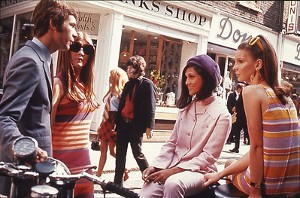
Image The National Archives UK, No known copyright restrictions via flickr
Introduction
When people think about 1960s fashion, they think about mini skirts, flares and psychedelic patterns.
This picture is misleading. Most people's image of the sixties only began in the second half of the decade. The term mini skirt was not in common use before 1966. The first mini skirts did not appear until 1965. Flower power and hippy fashion did not begin until the closing years of the decade.
One constant in the 1960s was denim and its increasing popularity with the young which began in the 1950s.
Elsewhere in fashion there was dramatic change. No one in 1960 would have imagined a woman would wear a skirt at mid-thigh length. No one in 1960 would have imagined a man would wear a pink paisley shirt and matching tie. Both these trends were in mainstream fashion by 1970, not just for the very hip.
What is more remarkable is that for most people the change did not take place over the course of the decade, but between 1965 and 1970. Fashions up to 1964 for most men and women was evolution from the 1950s, not revolution.
What was the reason for the change and how did it happen? What were the reasons for these changes?
Teenage fashion
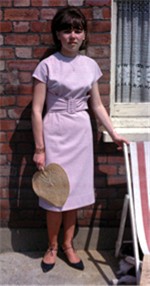
1960s fashion was about youth. New retail businesses opened to appeal to teenagers. Older people were not ignored and mainstream businesses, such as Marks and Spencer, evolved their clothes to serve mainstream taste.
It was the youth market that changed how Britain looked. But why was the youth market so important and why was it specifically important to the 1960s?
In the 1960s it was common for working-class teenagers to leave school at the earliest opportunity. That was age fifteen. They went into better-paid jobs compared to the previous generation. Earnings were rising for everyone in the 1960s, but pay for young workers rose at twice the rate for adults between 1938 and 1958. [1]
At the same time cultural changes meant that young people's wages were seen as their own and not belonging to the family. Before the war a working-class boy or girl gave most of their money to their parents and got some pocket money back. After WWII young people paid their parents about 30% for housekeeping and kept the rest.[1]
Most young people did not think about saving. Fear of 'the bomb' was justification to live for the moment. So they spent their money on having a good time. That meant going out, buying records and buying clothes.
High spending on clothes was not new for young people. Before the war adolescents were able to dress well in cheap, but fashionable clothes. The difference was in the spending power they had at their disposal. In 1967, the 15-19 year old age group contributed 50% of the total spent on fashion. [2]
Young people had the money to spend. Youth fashion was a growing business. A few pioneers, by chance or by design, recognised this trend. They made names for themselves, as well as huge fortunes.
Evolution from the 1950s
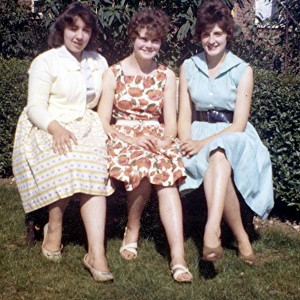
So we know that young people spent lots of money on clothes. What did they buy?
Fashion in the previous decade was led and almost controlled by a small number of couture (fashion) houses in Paris. Their clientele were wealthy, older and more sophisticated than the average 1960s' teenager.
The style of the 1950s was influenced by Christian Dior's 'New Look' from 1947. Skirts were mid-calf. The waist was tiny and pronounced. The style was a reaction against the cut-down look of war-time Utility clothes. Throughout the 1950s Dior and other Paris fashion houses designed a series of fashion lines. The top end of society bought into these images and spent heavily on fashion.
For the majority of women, chain stores made look-alikes of the less extreme of these creations within a few months.
The 1950s' look for most women was a full skirt, sometimes with a stiffened petticoat underneath. In the early 1960s the overall look softened and became more natural. A tighter fitting sheath skirt was also fashionable. Coats were large, almost like a tent. There was the A-line in dresses and coats. The A-line was like a capital A letter shape.
The other influence, particularly on older women, was the designer Coco Chanel. She re-opened her fashion business in 1954. Her designs were an evolution from her 1930s' look rather than the radical departure of Christian Dior's 1947 'New Look'. The classic Chanel suit in tweed or wool was comfortable and easy to wear. Her styles influenced clothing retailers catering for ordinary women.
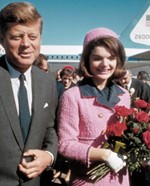
Jackie Kennedy was a role model for mature women in the 1960s. She is pictured, right, with John F Kennedy in the pink Chanel suit she wore on the day of his assassination. Later, stained with JFK's blood, it became one of the most famous pieces of clothing in history.
The Chanel suit remained a classic fashion item throughout the 1960s.
There was some change at the start of the 1960s. The hemline had moved up to just below the knee.
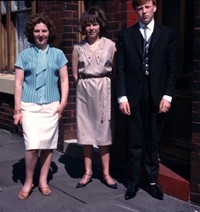
The look was still mature. There was no attempt to look that different from the older generation. You can see this style in films such as 'Saturday Night and Sunday Morning' (1960).
This group, left, are from around 1963. The young man has a dark suit, leather waist coat and a slim jim tie. He is wearing winkle picker shoes with pointed toes. The girls are conservatively dressed. The hemlines are still below the knee. They are wearing chain store or catalogue fashion and are yet to be influenced by the Swinging London look.
Mary Quant
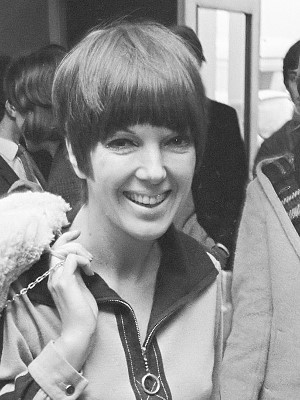
Jac. de Nijs / Anefo, CC0, via Wikimedia Commons
Mary Quant had a huge influence on how women looked in the 1960s. Quant was the daughter of two Welsh school teachers who lived in London. She studied art at Goldsmiths College. She started her fashion career working for a hatmaker.
She made custom designs for wealthy customers. Quant wanted to cater for women of her own age and on a limited budget.
She opened her first shop, Bazaar, on the King's Road in Chelsea in 1955 with Alexander Plunkett-Greene (to whom she was married from 1957 until his death in 1990). Whilst Quant's background was ordinary, Plunkett-Greene's was not. His father was at Oxford with Evelyn Waugh and his mother was a first cousin of the well-known philosopher, Bertrand Russell.
Quant and Plunkett-Greene were members of the Chelsea set; an exclusive clique of well-connected young men and women. When they opened Bazaar these young people were their customers.
Quant started Bazaar as a retail business, selling other people's designs. It was immediately successful, but Quant was dissatisfied with the clothes available for her to buy. So she started to design and make her own clothes.
Her clothes were different from the Paris couture and different from the mainstream mass market. Her original clientele was a narrow section of society that populated Chelsea's coffee bars. They were young, rich and not working class. Quant's clothes were expensive and in their way just as exclusive as those of the top designers.
She did, however, have her finger on the pulse of what the young woman with avant garde taste and more than modest means wanted.
Quant was first noticed by the fashion world at the end of the 1950s.
According to the Daily Mirror, by 1960 she had already a list of fashion firsts. She introduced the 'Slim-Jim' knitted dress in 1955. In 1956 she introduced the schoolgirl style. Her black stockings started the beatnik fashion. In 1957 she sold leather ski clothes designed by Anthony Armstrong-Jones (later the 1st Earl Snowdon and married to Princess Margaret from 1960-1978). In 1958 she introduced knickerbocker pants. 1959's dresses were long-bodiced finishing with a lampshade style frill. In 1960 her style was pre-empting the 1960s. She introduced a schoolgirl gym tunic that was to be her trademark. [3]
In 1960 Vogue featured her grey and black flannel pinafore dress worn and beatnik-style black sweater.
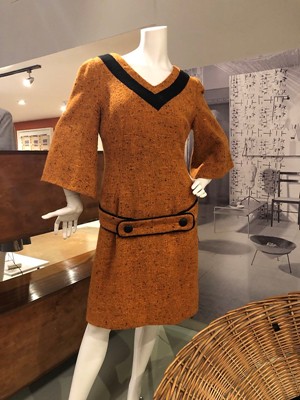
Image by MsAnthea, licenced under Attribution-NoDerivs 2.0 Generic (CC BY-ND 2.0)
Quant's feel for what her public wanted was second to none. She was not catering to the beatniks or even to teenagers who adopted the beat look. Their style was radically different. They wore black jeans, long and baggy sweaters or black polos. Beatnik women and girls wore black tights. They did not spend a fortune on clothes. It was a do-it-yourself look.
Others did not have her touch. Yves Saint Laurent's last collection for Dior in 1960 was called 'The Beat Look'. It featured plenty of black leather, turtle-neck collars and black knitted caps. Models had pale zombie-like faces. It was a failure. The wealthy did not want to look like beatniks. [4]
Quant's customer base had expanded from the immediate Chelsea set. In 1961 she opened a second shop in Knightsbridge. Her customers were not teenagers, but she did have a cult following. Some people made the trip down from the North of England to shop at Bazaar. Prices were high. In 1961 a soft chiffon after-dark dress with black and white paisley pattern cost 23½ guineas from Bazaar (in today's money £400). [5]
Quant was not alone in catering to a wealthy customer base wanting a younger look. Several up-market stores opened their own young fashion boutiques. Woollands department store in Knightsbridge next to Harvey Nicholls opened Woollands 21 Shop in 1961. Harvey Nicholls' had Little Shop. There was Young Jaeger, as well as Simpsons Young and Gay. ('Gay' in this context has the original meaning - light-hearted or carefree).
Quant knew that she would sell more at lower prices. Sale days at Bazaar were crowded and sold out in no time. In July 1961 she had her dresses manufactured and sold wholesale to other retailers. [7]
Mary Quant's style spread further from her Chelsea set in the next few years. In 1963 she coined the term 'The Look' to describe a complete outfit including shoes and accessories that she provided.
She expanded further in 1963 when she started exporting to America. She started the Ginger Group label in 1963.
The Look
Mary Quant coined the phrase 'The Look' to describe a complete look, including clothes and accessories. 'The Look' was the phrase to describe the fashions of the mid-1960s. Everything about it was short and neat. Skirt lengths had become shorter in the early years of the 1960s, but made it to above the knee by 1965.
There is some debate over who invented the mini skirt. Mary Quant's boutique, Bazaar, on the King's Road, Chelsea was one of the first places to sell them in 1965. French fashion designer, André Courréges, also added mini skirts to his fashion collection in 1965.
John Bates, who designed Diana Rigg's outfits for the Avengers put her in short skirts and dresses. He favoured bold geometric designs. The series helped popularise 'The Look' throughout the country. Cathy McGowan who fronted 'Ready, Steady Go', a forerunner of 'Top of the Pops', also showcased the latest designs. She chose outfits from Mary Quant, Tuffin and Foale and Biba.

The mini skirt and mini dress caught on throughout the country in the years following 1965. Most women took a couple of years to accept the new look. For the mini to work, the old-fashioned underwear and stockings of the 1950s had to go. Women now wore tights or pantyhose.
Barbara Hulanicki and Biba

Image: Wellcome Collection, licensed under Attribution 4.0 International (CC BY 4.0)
Barbara Hulanicki opened the first Biba shop in the Abingdon Road in Kensington in 1964. She started the business a year earlier as Biba's Postal Boutique with her husband, Stephen Fitz-Simon. She got lucky when Felicity Green, the Daily Mirror's fashion correspondent, asked her to design a dress for a feature. Hulanicki designed a pink gingham dress. The subsequent exposure in the national press saw Biba overwhelmed with orders, which Hulanicki and her husband struggled to fulfil. Nevertheless it was the beginning of something great.
Biba was different for two reasons. First it was cheap. Unlike Quant's clothes, Hulanicki's were at teenagers' prices. Secondly Biba anticipated the future of the 1960s.
The future was the past. Hulanicki took over the lease on a dilapidated chemist's shop, N F Tyler, on the corner of Abingdon Road and Scarsdale Villas. It had a faded peeling facade, which she refused to change. Inside she redecorated in an antique style. She put black and white tiles on the floor which were inspired by the Polish Court in the film 'Ivan the Terrible'. There was an antique Dutch wardrobe, William Morris curtains and bronze lamps. [8]
It was a vision of the past, but no particular period. This was the formula that Hulanicki and Fitz-Simon would repeat with grander visions in successively larger Biba stores.
Biba's colours were sludge colours, plums, browns and greens. Nevertheless her clothes were designed for the young and slim.

Peloponnesian Folklore Foundation,
Hulanicki's vision moved with the times from William Morris to Art Nouveau and finally Art Deco. The clothes followed into a fantasy of the Edwardian and 1930s eras combined. It was a perfectly in tune with the final years of the decade.
The boutique
Inspired by the success of Biba and Bazaar, huge numbers of boutiques sprung up all around the country. In Oxford and the surrounding area eight new boutiques opened between 1967 and 1971.
London was the fashion capital of Britain, as well as the real capital.
London was awash with boutiques. A few from the mid-1960s were Countdown, Blast Off, Top Gear, Change Down, Glad Rags, Clobber, Quorum (Ossie Clark), Ad Hoc, Palisades and Barricades.
Most boutiques were expensive. A simple shift dress cost around £10 (at least £100 in today's money). For those with smaller pockets there were Wallis, Neatawear and Top Shop. Top Shop's range in the 1960s included designs by Mary Quant.
If the price did not put you off, 'The New London Spy (1966)' had a word of warning about your figure. To find suitable clothes at a boutique a woman had to be tall and thin with no breasts to speak of.[9]
If Swinging London was not to your taste, Jaeger made sweaters, suits and coats that lasted forever. Marks and Spencer still meant quality and value. But some of their dresses and suits were a little too classic. M&S was also the best place for underwear.
Late 60s fashion
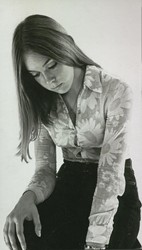
Everything changed from 1967 in the wake of the 'Summer of Love'. The flower motif had a strong influence on fashion and the 'The Look' of the mid-sixties now seemed old hat.
Fashion in the mid-sixties was led by designers such as Quant and Hulanicki. By the end of the decade, they were losing some of their influence and fashion was more do-it-yourself. Paisley and psychedelic patterns were popular with men as well as women. Young people abandoned the glossy products of the consumer society and preferred to mix denims with army surplus.
1969 and after
As the decade ended, hemlines started to drop. The maxi and midi lengths offered women an alternative to the mini.
References
[1] 'The rise of the consumer society in Britain 1880-1980' by John Benson, published Longman 1994, page 18.
[2] '1966 and all that' by Jennifer Harris, Sarah Hyde and Greg Smith, published by the Trefoil Design Library 1986, page 109.
[3] 'Oh! The chic of the girl: Miss Quant finds it pays to be Quaint', published in the Daily Mirror, 24 October 1960, page 9
[4] 'In Vogue, six decades of fashion' by Georgina Howell, published by Allen Lane, 1975, page 275.
[5] 'Style that goes with a swing' by Katherine Whitehorn, published in the Observer, 12 March 1961, page 32.
[6] 'Autumn in the stores' by Alison Adburgham, published in The Guardian 29 September 1961, page 8.
[7] 'Mary Quant is going wholesale' by Alison Adburgham, published in The Observer 9 June 1961, page 26.
[8] 'From A to Biba, The autobiography of Barbara Hulanicki, published Hutchinson & Co 1983, and reprinted by V&A publications in 2007, page 75
[9] 'The New London Spy' by Hunter Davies, published by Blond (1966), page 87


Comments
Fashion was fabulous then - and most young people were slim. It made it possible to look good in minis, tight pants etc. Then the big food manufacturers brought out their mass market junk and such a majority of young people are so overweight today. I grew up in the sixties, I did a bit of modelling, and I’m the same weight today 52kilos. Plus still got my shoulder length hair! The 60s were the most exciting time to grow up. I even went to a Beatles concert - 12 seats from the front!